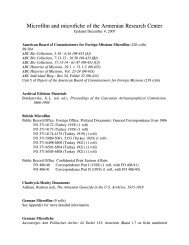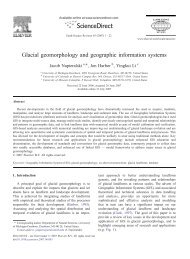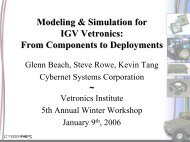Introduction to On Board Diagnostics (II)
Introduction to On Board Diagnostics (II)
Introduction to On Board Diagnostics (II)
You also want an ePaper? Increase the reach of your titles
YUMPU automatically turns print PDFs into web optimized ePapers that Google loves.
Fundamentals of PowertrainControl strategies & OBD <strong>II</strong><strong>Diagnostics</strong>After all fault codes are cleared, the mechanic has several choices of test modes including:♦ Request current powertrain diagnostic data (mode $01)♦ Request current powertrain Freeze Frame” data (mode $02)♦ Request Emission related DTCs♦ Request OBD <strong>II</strong> test results of continuouslymoni<strong>to</strong>red / non-continuously moni<strong>to</strong>red systems♦ Request control of OBD <strong>II</strong> system.Mode $01: The purpose of this mode is <strong>to</strong> allow access <strong>to</strong> current emission related data values. The request forinformation includes a Parameter Identification(PID) value that indicates <strong>to</strong> OBD <strong>II</strong> the specific information requested.PID definition, scaling information, and display formats are included in SAE J 1979. for compliance.The OBD <strong>II</strong> module will respond <strong>to</strong> this message by transmitting the requested data value last determined by the PCM.All data values returned for sensor readings will be actual readings, not default or substitute values used by the PCMbecause of a fault with that sensor..Not all PIDs are applicable or supported by all systems. PID $00 is a bit encoded PID that indicates, for each module,which PIDs that module supports. PID $00 must be supported by all modules that respond <strong>to</strong> a Mode $01 request asdefined in the standard SAE J 1979, because <strong>to</strong>ols that conform <strong>to</strong> SAE J 1978 use this request <strong>to</strong> determine the pro<strong>to</strong>colinformation supported for OBD <strong>II</strong> communications.
















